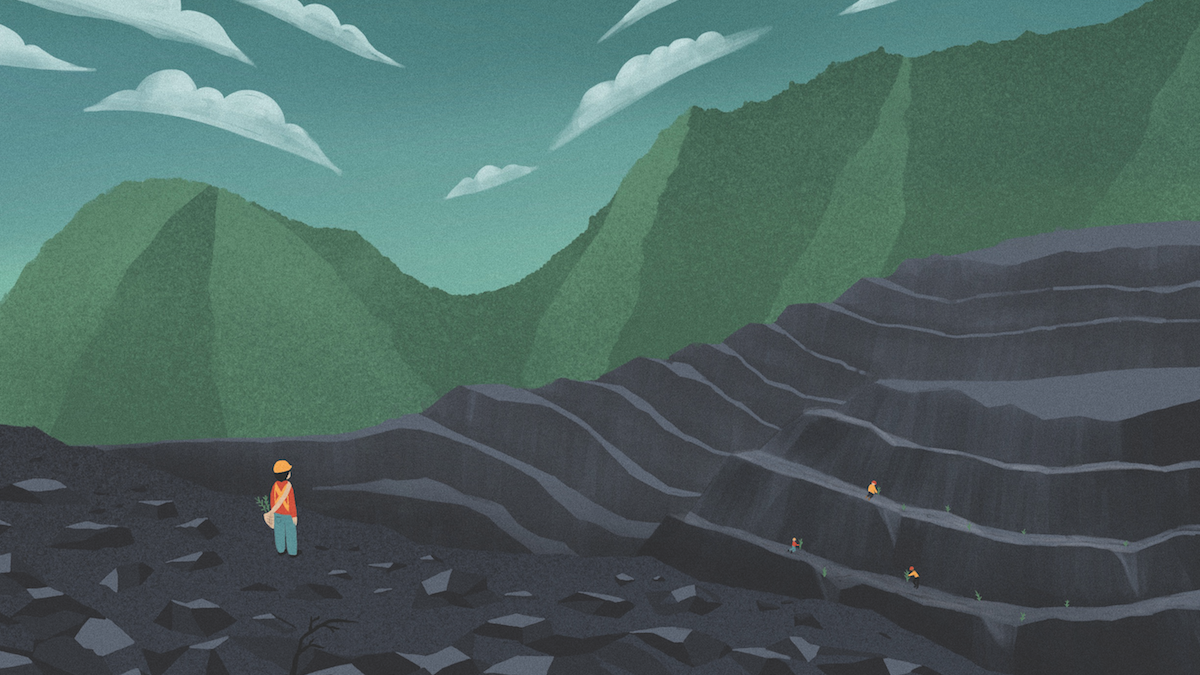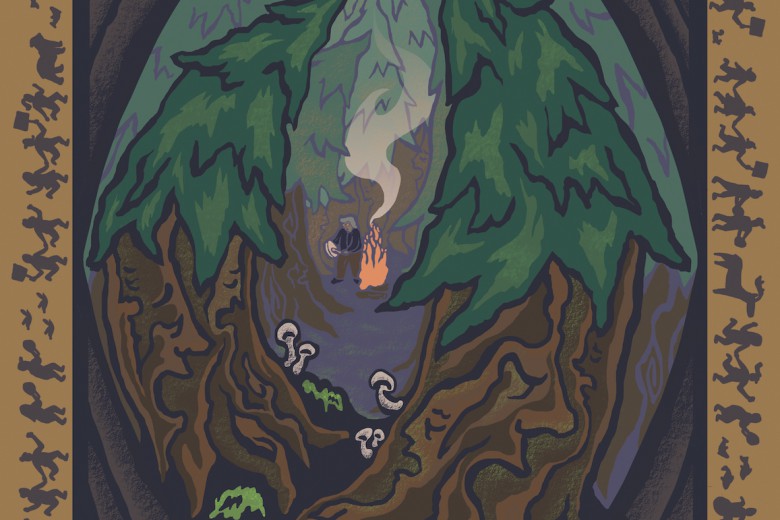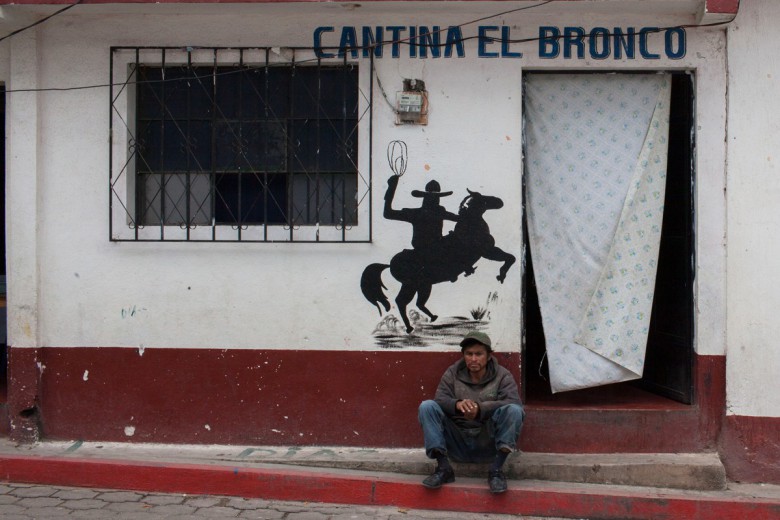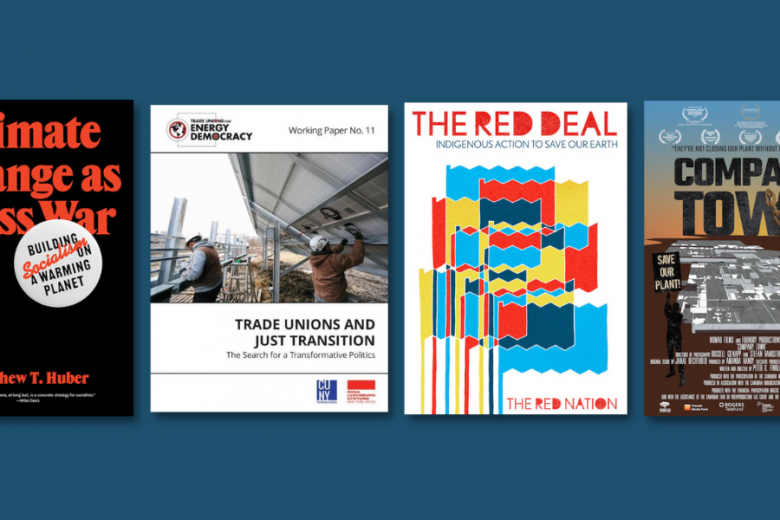The first thing we were told when we started working as tree planters for Teck Coal’s reclamation project was that we were forbidden from taking pictures in the mine. Looking around the site, at the southern edge of the Rocky Mountains in the Elk River valley on Ktunaxa territory, we understood why. We were in a 203 square-kilometre open-pit coal mine, just one of the four that Teck Coal operates here. The level of disturbance was far beyond any forestry cutblock we’d ever seen. Snowy peaks, meadows, and subalpine forests – once habitat for grizzlies, bighorn sheep, and elk – were now a wasteland of blast rock, tailings ponds, and smokestacks. Candid photos would be damning, but a picture could hardly capture the extent of what was going on here.
In the spring of 2022, the planting company for which Caleb and I have worked for several seasons was contracted by Teck Coal Ltd., a subsidiary of Teck Resources Ltd., to implement their newly expanded reclamation project. Mine reclamation is intensive in terms of time, money, and labour, but it has been hailed by organizations like Nonprofit Quarterly, the World Bank, and the World Resources Institute as an integral part of a just transition. If we can replace jobs mining coal with jobs cleaning up coal mines, the theory goes, workers can continue to feed their families while the world economy greens. Teck promises its own reclamation efforts will not only create jobs, but will have a “Net Positive Impact,” meaning “ecosystems and biodiversity are better off at the end of mining than when we found them.” We soon learned from our project managers that Teck had significantly ramped up its planting program, from around 500,000 to 3.5 million seedlings each spring and that they hired some 80 additional planters and staff, including us, to fulfill this promise.
As tree planters, we’ve resigned ourselves to the fact that our work enables industrial forestry to continue. Tree planting, at least in B.C., is not saving the world. We are boots on the ground, barely different from the loggers, making a buck off of what was once a complex forest landscape. The trees we plant are destined for harvest; future two-by-fours. Or toilet paper.
In March 2021, Teck was found guilty of knowingly polluting waterways under the Fisheries Act. They were forced to pay a one-time fine of 60 million dollars to the Canadian federal government – equivalent to just 1.5 per cent of their gross profits for that same year.
And yet, in the clear-cuts there is life: fawns and baby rabbits and birds’ nests; toads and turtles. We’ve waded through greenery up to our armpits, ducked and woven through alders, been stung by wasps and reduced to sneezing balls of allergies from the pollen and fireweed. On hot days, shade from the residual trees and clear flowing streams (or even stagnant, algae-filled mudholes) offer relief. Forestry cutblocks are scars on the landscape, to be sure, but scars indicate potential healing. No such life greeted us in the mines; the lifeless, black blast rocks of the mine indicated death. Everything that had been there was completely blown apart.
As we began planting, we sought to learn more about the context of the reclamation efforts. After work, during the truck ride home or while waiting our turn to shower, we began to read and research. We learned that in 2021, Teck grossed over $3.6 billion before depreciation and amortization from just these four mines – and we learned who was shouldering the cost. Sixty-six million tonnes of CO2 are emitted just from the coal that comes out of the Elk River valley, and the emissions released through the production, transport, and use of Teck’s Elk River valley coal are greater than that of the rest of B.C. combined.
Downstream from the coal mines, selenium is actively polluting waterways and Teck is fighting successfully to avoid accountability. Concern about pollution from the mines stretches back to 1995, when studies first began to show the impacts of selenium on local fish populations. Now Indigenous governments, British Columbians, residents of Montana and Idaho, and even U.S. President Joe Biden have begun calling for an international investigation that so far has been stalled by the Canadian government. Selenium occurs naturally in rocks and is released into the surrounding environment in low levels as rocks weather – it’s considered safe for human consumption at a maximum concentration of 10 parts per billion. When entire mountains are exploded into fist-sized pieces and piled up, the selenium in those rocks leaches out in much higher concentrations. Throughout the Elk River valley, selenium levels have been found at 50 or 70 parts per billion. In the surrounding rivers, streams, and Lake Koocanusa – where Teck has fought to scrap pollution regulations – selenium pollution has led to poor health, reproductive failure, and population decline in red-winged blackbirds and dozens of invertebrates. And thanks to selenium, populations of the culturally significant westslope cutthroat trout have dropped by about 90 per cent between 2017 and 2019.
Our job was to plant into these rocks. We scrambled around the jagged piles, tucking root-plugs into the pockets of finer gravel and smaller rocks between boulders, wishing luck to each little plant.
In March 2021, Teck was found guilty of knowingly polluting waterways under the Fisheries Act. They were forced to pay a one-time fine of $60 million to the Canadian federal government – equivalent to just 1.5 per cent of their gross profits for that same year. In exchange, Crown prosecutors agreed not to pursue related charges from 2013 to 2019. This slap on the wrist ignored the fact that, in 2017, Teck’s “state of the art” selenium treatment plant at Elkview Operations was actually found to be releasing additional selenium into the surrounding waterways and that, a year later, watchdogs accused Teck of deliberately suppressing water contamination data. Large emitters like Teck have the corporate might to avoid meaningful and proportionate consequences for their actions, blowing up mountains while claiming to be world leaders in “sustainability.” Meanwhile, the people most affected by their operations are lied to about the ecological and health impacts.
Yet locally, Teck has strategically made itself indispensable. With more than 4,000 employees in the Elk River valley, Teck is by far the region’s largest employer. On our days off, we went to aquatic centres and parks in Elkford, Sparwood, and Fernie, all proudly displaying signs listing Teck as a sponsor. Pickups sporting buggy whips and amber lights – required PPE for all vehicles that enter the mines – fill the driveways and parking lots in the area. Through reliable and lucrative jobs and corporate sponsorships, Teck has cemented its position and gained financial leverage in both Indigenous and settler communities. Evidence that the investment has paid off is found in the open comment section for Teck’s proposed Castle Mountain/Fording River extension project: roughly half the comments call out the damage the mines cause, but the other half proudly give the project their blessing. After all, Teck feeds their families and – until climate disasters catch up with them – putting food on the table still comes before functioning ecosystems. We know that will not always be the case.
In the mines themselves, as we were planting, we listened to dynamite blasts echo across the barren landscape. Diesel-fuelled haul trucks the size of houses rumbled back and forth throughout the mine, bringing the blasted rock and coal dust to freight trains bound for Vancouver. From there it is sent via bunker-burning cargo ships to Asia and India to fuel furnaces that make steel and pump out greenhouse gases and pollutants. Teck’s Elk River valley operations are a major player in the global steel industry, which in turn drives climate change: between 5 and 8 per cent of all global emissions come from steelmaking. Teck claims to be “one of the world’s lowest-carbon intensity” coal miners, but as the planet warms, being the least bad should be no source of comfort.
So there we were in the mines, shovels in hand, planting spruce and pine, wild rose and Saskatoon berry, fescues and wheatgrass, tasked with trying to alleviate some of these immense harms. The reclamation program mostly involves rebuilding the former mountain from the pieces of blasted rock that have already been stripped of their prehistoric coal deposits. Our job was to plant into these rocks. We scrambled around the jagged piles, tucking root-plugs into the pockets of finer gravel and smaller rocks between boulders, wishing luck to each little plant. Without any soil, water, nutrients, or shelter, surely, we thought, most of what we were planting would die?
In the mines, the dirt plugs around the roots of the plants crumbled into dust in our hands and we saw more fossilized plants than living ones.
For a conventional logging cutblock, survival rates of what’s planted vary based on the region and site – but it’s common knowledge among planters that anything less than a 90 per cent survival rate is considered unacceptable. The survival rates on Teck’s reclaimed areas are not published and the Teck spokespeople with whom we talked were not forthcoming about these details. Indigenous communities and mining watchdogs alike have expressed concern about the Teck’s utter lack of reclamation transparency. One reclamation report from 2010 boasts that, under ideal circumstances, survival can approach 50 per cent. That same report acknowledges how challenging it is for seeds and seedlings to survive in waste rock. A 2017 reclamation report even admits that it will take “decades to centuries to re-establish the complexity of ecosystems” lost to mining. Further, although Teck’s mines are inspected by reclamation experts working for the province, these publicly available reports contain little information about the state or health of reclaimed areas, just notes about where on the site the inspectors were brought. The implication seems to be that, as far as the regulators are concerned, evidence of reclamation effort is a sufficient stand-in for evidence of reclamation success.
There is satisfaction that comes from planting a good tree in good soil. As the cool mineral dirt closes firmly around a solid plug, you can feel how this tree will take root and thrive for 40 or 60 years before it’s harvested. Yet in the mines, the dirt plugs around the roots of the plants crumbled into dust in our hands and we saw more fossilized plants than living ones. On mine blocks planted in previous years, dead dusty plugs fell out of the holes we opened. Every instinct told us that planting in this environment was largely futile.
“It seemed unproductive, since the plants would most likely not survive,” recalls Taylor Veperts, who worked alongside us as a planter this spring. “It was extremely tough to plant them properly and the soil quality was horrible. […] Overall, it was not what I signed up for.”
We were planting the ghost of a mountain, putting trees into a rocky graveyard. How could Teck be claiming this as a success? Could these restoration efforts even begin to mitigate the level of destruction felt in the mine, let alone compensate for the downstream effects to waterways or on the global climate? To be sure, that is beyond the scope of the reclamation requirements in B.C.’s Mines Act and it’s beyond the aims of Teck’s reclamation compliance reports and five-year plans – but is it beyond the repeated promise of a “Net Positive Impact”? At least in glossy handouts, Teck remains proudly committed to that goal, stating “our conservation, protection and restoration of land and biodiversity will exceed the disturbance caused by our mining activities.” So why did it feel like there was such a contradiction between what Teck was promising and what we saw on the ground?
One clue can be found in the pages of the 2017–2021 Five Year Mine and Reclamation Plan. Under the operating assumptions, it is stated that “active mining will cease at the end of 2047.” But Teck’s proposal to extend the lifespan of its Castle Mountain/Fording River coal mine in B.C. is currently undergoing a federal environmental assessment process that it is expected to pass. If the proposal is permitted, this mine would remain open until 2070, extracting 10 million tonnes of coal per year. This would allow Teck to defer its reclamation obligations, kicking the can further down the road into our shared uncertain future. Demonstrating that reclamation work is currently underway, then, is a key component of Teck’s strategy to expand its future operations. By operating under the assumption that mining will cease in 2047, while actively working to push operations ahead to 2070, Teck’s actions speak louder than their words: the reclamation project is greenwashing.
"Our misplaced grief, inability to have pride in our efforts, and their careless treatment of our physical body, all for a job we saw as futile, perpetuated an environment of frustration and disempowerment.”
As the season progressed and we felt increasingly dismayed about the project, morale in camp fell off. Planting camps can be beautiful, tight-knit communities, full of music and laughter, dance parties, and afternoons off at the lake. And even under depressing conditions, much of that persisted, reflecting the strength and resilience of the planters with whom we worked. Music helped, as did the chance to plant conventional blocks. We held a fundraiser for the Ktunaxa Nation’s Traditional Knowledge program and made memes to capture the range of emotions we felt. Still, the vibe was suffering. One fellow planter, Isabella Providenti, shared that “it became obvious as the season progressed that the persistent exposure to environmental degradation, disrespect and casual disregard for our situation by our employers made our ability to do our job as labourers difficult. Our misplaced grief, inability to have pride in our efforts, and their careless treatment of our physical body, all for a job we saw as futile, perpetuated an environment of frustration and disempowerment.”
We watched petty squabbles flare up between old friends and colleagues, saw people in leadership positions burn out, and felt the shared frustration at what we had found ourselves taking part in. When we asked the Teck employees overseeing our reclamation contract about the actual environmental impacts of our work and the eco-grief we were feeling, we were brushed aside and told that we were on the “right side of history.”
When organizations say mine reclamation is part of a just transition, the premise is that there will be a transition away from coal mining. Teck capitalizes on the association, paying lip service to the premise before ultimately disregarding it. All the glossy documents, all the talk of “Net Positive Impact” and sustainability, all of the reclamation work is just another cost required for business as usual to continue.
Resource extraction companies know that they are being more closely watched by the public and by policymakers – and this means they must put up at least the appearance of cleaning up their messes.
Corporate mapping further reveals Teck’s hypocrisy. Teck board member Tracey McVicar also sits on the board of directors for the Fraser Institute, a B.C.-based conservative think tank known for climate change denial. The Fraser Institute participates in the Atlas Network, a group of libertarian policy lobbyists who have fought to limit Indigenous communities’ rights to push back against resource extraction. Other Teck executives have donated directly to Republican electoral campaigns and some of Teck’s board members also sit on the boards of major corporate oil and gas players like TC Energy. Teck Resources Ltd.’s shareholders include RBC, the primary funder of the illegal Coastal GasLink pipeline that’s being built through unceded Wet’suwet’en territory; and the People’s Republic of China, a main buyer of Teck’s coal exports. Teck’s senior leadership’s actions highlight the web of lobbying, propaganda, and funding that stall meaningful action toward a just transition.
And indeed, as far as profit goes, these strategies are working exactly as planned. Teck’s recently retired CEO, Donald Lindsay, was paid over $9 million by the company in 2019. Shareholders saw gross quarterly profits quintuple from $689 million a year ago to a staggering $3.3 billion this year, with steelmaking coal accounting for three quarters of that profit. That profitability allowed for $662 million in share buybacks and $800 million in debt repayment, all while maintaining a liquidity of $8.4 billion. In other words, despite directly fuelling climate change and poisoning waterways, Teck – so long as it can keep producing coal – is extraordinarily profitable.
As Teck’s proposal to extend the life-span of its Castle Mountain/Fording River coal mine lingers under review, Teck will tout its expanded reclamation program in the Elk River valley as evidence that it is capable of putting the mountains back the way they found them. That claim deserves to be challenged. Still, the truth is we can’t know what these sites in the Elk River valley will look like in 50 or 100 years. Planting is only one part of Teck’s reclamation operations; for example, heli-seeding operations are also underway. What’s more, nature is superbly resilient, complex and, increasingly, unpredictable. We take heart from a recent example: in Toronto’s Port Lands, construction crews working on re-naturalizing the mouth of the Don River accidentally exposed seeds that had been buried underneath sewage and landfill for over a century – and were astonished when these seeds began to sprout. Under even the most unlikely circumstances, plants will try to flourish.
In the mine there were small hints that, despite all odds, the reclamation could have a chance: elk lingered on the edges of the mine site and bighorn sheep, raggedy and coated with coal dust, occasionally scrambled through the rocks.
Ten years ago, reclamation, sustainability, social governance, and stewardship were not words in resource extraction companies’ lexicons. Today, we are in the middle of a paradigm shift. Resource extraction companies know that they are being more closely watched by the public and by policymakers – and this means they must put up at least the appearance of cleaning up their messes. But impossibly lofty promises are not enough; regulators, workers, and the public should demand transparency and accountability for exactly what these promises look like on the ground. Teck’s expanded planting program comes as the forestry industry faces a long-expected downturn, so there is a real opportunity for reclamation work to substantially provide for workers. But planters ought to be able to consider the true motivations of their bosses, and the impact of their work.
In the mine there were small hints that, despite all odds, the reclamation could have a chance: elk lingered on the edges of the mine site and bighorn sheep, raggedy and coated with coal dust, occasionally scrambled through the rocks. We took this as a hopeful sign in a largely demoralizing situation. As humans – just as much a part of nature as the elk – we also have a lot at stake when it comes to reclamation. Our experience affirmed that we cannot trust major corporations to do anything but prioritize profit; that though the colonial government cannot be relied on to regulate and enforce environmental protections, it can be pushed by overwhelming public effort to be a channel for action; that communities of workers can find strength when they stand together; and that Indigenous-led resistance is a key pathway for change and Western science can back up traditional Indigenous knowledge. We cannot know what the future holds, but we can know what we work toward. Hopefully that amounts to more than Teck’s empty promises.







